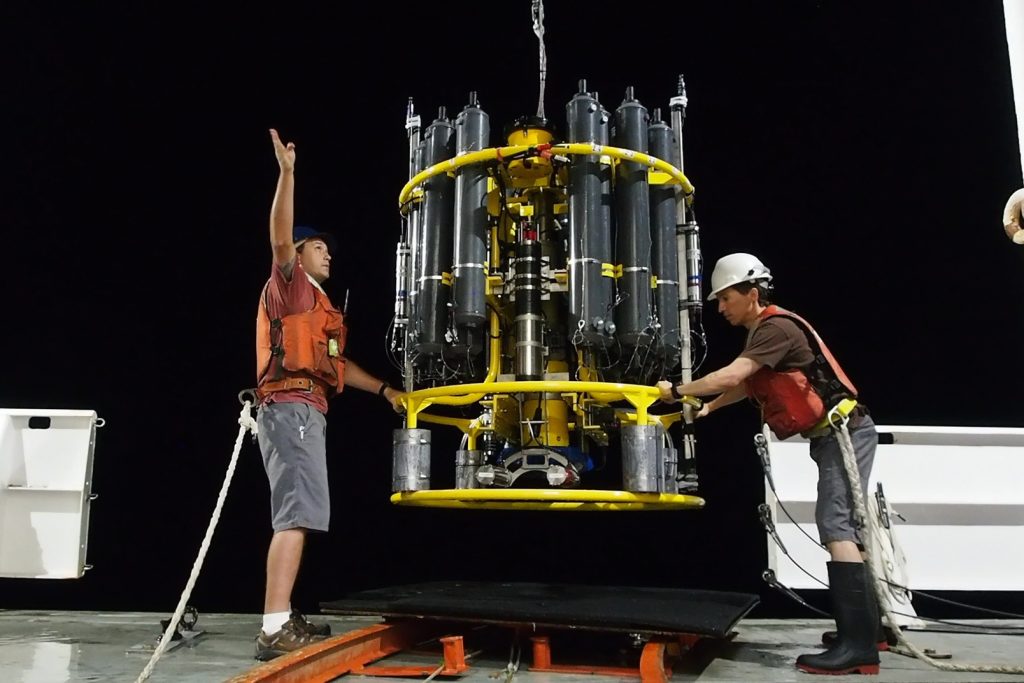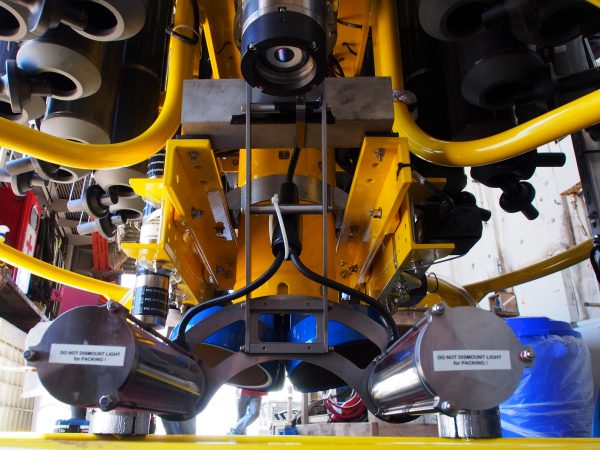Underwater cameras help identify carbon pathways in the ocean
July 13, 2016
Lauren Frisch
907-474-5022

Download story and caption in text format.
Underwater cameras may help reveal how tiny animals called zooplankton play a role in long-term carbon storage in the ocean.
Human-generated emissions are increasing the concentration of carbon dioxide in the atmosphere. This carbon dioxide may be used by plants or animals, or trapped in soil or water. It can take many paths from the air to the deep ocean. As scientists map out possible impacts from increasing carbon dioxide in the atmosphere, it is important to find out how much and what kind of carbon is transported and stored deep in the ocean.
“We use underwater cameras that show the type of particles in the water and the relative abundances of these particles so we can learn about how carbon is being used in the ocean,” said Andrew McDonnell, a professor at the University of Alaska Fairbanks School of Fisheries and Ocean Sciences. “This information helps us begin to evaluate the likelihood of carbon being stored in the deep ocean.”
Different regions of the earth, atmosphere and ocean can either absorb or emit carbon. This balance of storing versus emitting carbon is called the carbon budget. Uptake of carbon by the ocean is one of the primary mechanisms removing carbon from the atmosphere. As a result, complex carbon pathways in the ocean strongly affect the overall carbon budget.
Carbon can exist in many shapes and sizes. One way to study how carbon moves around the ocean is to measure the distribution of different-sized particles. Particles can include living things like zooplankton and phytoplankton, the tiny animals and plants at the bottom of the food chain, as well as nonliving things like sediment and fecal pellets.
Large particles tend to contain more carbon than small particles. Additionally, their larger size generally makes them sink to the deep ocean more quickly. McDonnell and SFOS graduate student Jessica Pretty are studying what the size and composition of particles in the ocean can teach us about how quickly carbon sinks.
Zooplankton eat and digest other particles, which can alter their size and density. Using underwater vision profiler cameras, known as UVPs, Pretty and McDonnell want to figure out if zooplankton are building up or breaking down particles in a greater quantity, and if these trends vary by species.

The UVP is much more than a camera in an underwater case. It has an onboard computer that allows it to analyze the images, generating data on the number, sizes, shapes and other attributes of the particles captured in each photograph. The UVP can do all of this at high speeds, capturing and analyzing about six images per second.
UVP cameras have an advantage over conventional collection techniques like sediment traps that collect samples over a period of time.
“The camera gives a real-time snapshot of what particles look like undisturbed in the water column,” Pretty said. “The photos we take allow us to see events and features in the ocean that might not be possible to see in the material collected by a sediment trap or other methods.”
Pretty wants to discover whether the UVP can detect differences in the zooplankton communities in two different ocean environments. Her first set of images was taken in the Gulf of Alaska in July 2015. The second set was taken the same summer on a 5,000-mile straight transect between Tahiti, a French Polynesian island in the Pacific Ocean, and Kodiak, Alaska.
A year later, researchers are still working to fully process data from the trip. Pretty expects to see different kinds of zooplankton in each of her samples, because the Tahiti to Alaska cruise crossed through habitats that can have different kinds of zooplankton communities.
The open ocean is also deeper than coastal water. Pretty explains that the ocean is thousands of meters deep on the Tahiti transect compared to hundreds of meters deep on the Gulf of Alaska shelf.
“I am curious to evaluate if we see similar patterns of zooplankton in relation to particle size structure in these contrasting environments,” Pretty said. The research is supported by the National Science Foundation and the Northern Gulf of Alaska Applied Research Award. The UVP was purchased as part of an equipment grant from the M.J. Murdock Charitable Trust.
This research will also test the limitations of the cameras. Pretty is curious to see whether she will be able to extract information about particular species of zooplankton from the shallower Gulf of Alaska images, or if she will need to focus on trends for all zooplankton. Answers to these questions will help Pretty and McDonnell determine the kinds of questions they can ask in the future.
Understanding the different paths carbon can take — and the different forms it may travel in — will enhance the ability to determine the carbon-absorbing capacity of the ocean.
The cameras are vastly increasing the capacity for researchers like McDonnell and Pretty to understand how carbon moves around the ocean.
“I’m really excited,” said McDonnell. “We’ve discovered some interesting and surprising oceanographic features with these cameras. They are teaching us a lot about how the ocean’s carbon cycle works.”


